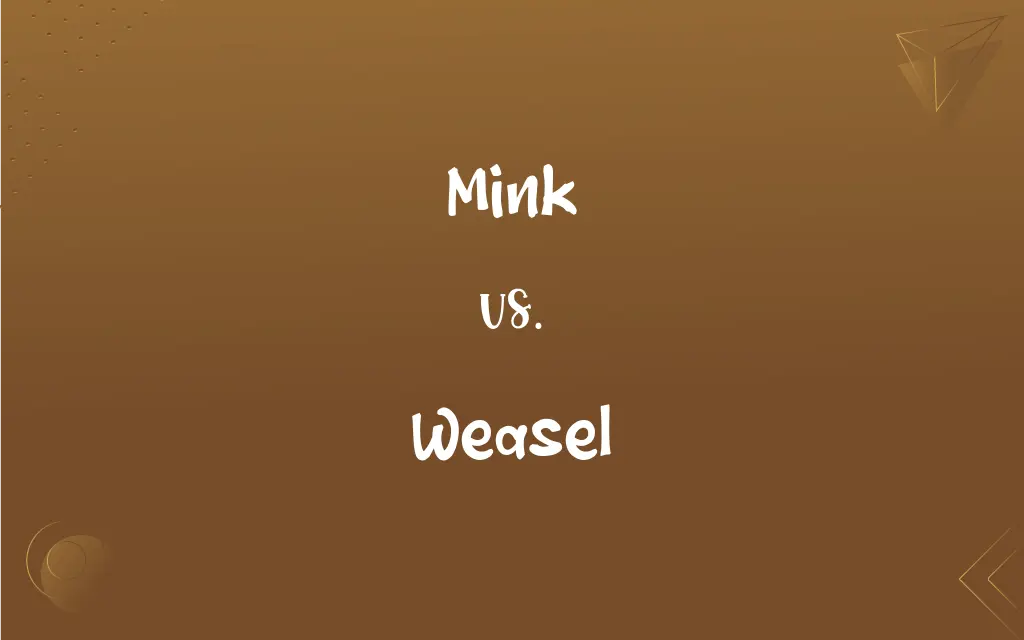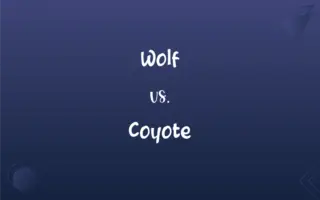Mink vs. Weasel: What's the Difference?
Edited by Aimie Carlson || By Harlon Moss || Updated on October 25, 2023
Minks are semiaquatic mustelids known for their fur, while weasels are smaller mustelids with elongated bodies and short legs.

Key Differences
Minks and weasels, both belonging to the Mustelidae family, display distinct characteristics. Minks, primarily known for their luxurious fur, have earned a significant place in the fashion industry. Their dense, soft fur has made mink coats a sought-after luxury item. On the other hand, weasels, despite their smaller size and distinctive elongated bodies, are not as popularly used for their fur.
Minks are semiaquatic animals, often found near water bodies. They have a streamlined body which assists in swimming, and their diet mainly consists of aquatic life. Weasels, contrasting the minks, primarily live on land. These creatures are terrestrial and have a diet that includes small mammals and birds.
Another distinguishing trait between minks and weasels is their size. Minks tend to be larger, with lengths ranging between 12 to 18 inches, excluding the tail. Weasels, however, are smaller, with some species measuring as short as 4 inches. This size difference is easily noticeable when the two are compared side by side.
Coloration also varies between minks and weasels. Minks usually come in a range of dark brown shades, often appearing almost black. Weasels, conversely, exhibit a wider range of colors, from brown to white, especially in regions where they change colors with seasons.
In the broader perspective of ecological roles, both minks and weasels play crucial roles in controlling rodent and other small mammal populations. Despite their differences, their predatory instincts and sharp reflexes make them efficient hunters in their respective habitats.
ADVERTISEMENT
Comparison Chart
Habitat
Semiaquatic, often near water bodies
Terrestrial, primarily on land
Size
Generally larger, 12-18 inches in length
Smaller, some as short as 4 inches
Fur Industry
Highly prized for their fur
Not as popularly used for fur
Diet
Aquatic life and small mammals
Small mammals, birds, and eggs
Coloration
Dark brown, often appearing almost black
Varies from brown to white with seasons
ADVERTISEMENT
Mink and Weasel Definitions
Mink
Mink is a member of the Mustelidae family.
Minks share some similarities with otters, another member of their family.
Weasel
Weasels belong to the Mustelidae family.
Weasels and badgers are distant relatives in the animal kingdom.
Mink
Mink fur is prized in the fashion industry.
The mink coat she wore was incredibly soft.
Weasel
Weasels have a diet that includes small mammals and birds.
The weasel pounced on the unsuspecting mouse.
Mink
Mink is a semiaquatic mustelid known for its fur.
The mink swam swiftly to catch its prey.
Weasel
Weasel is a small, elongated mustelid.
The weasel darted quickly through the grass.
Mink
Minks are carnivorous animals, feeding on aquatic life and small mammals.
The mink stalked the riverbank looking for fish.
Weasel
Some weasels change color with the seasons.
The weasel's fur turned white in the winter.
Mink
Minks usually have a dark brown fur coloration.
The dark hue of the mink's fur camouflaged it in the twilight.
Weasel
Weasels are known for their agility and quick movements.
With a flash, the weasel captured its prey.
Mink
Either of two semiaquatic mustelid carnivores, Mustela lutreola of Europe or Neovison vison of North America, having a pointed snout, short legs, and partly webbed toes. The North American species is bred for its commercially valuable fur.
Weasel
Any of various carnivorous mammals of the genus Mustela, having a long slender body, a long tail, short legs, and brownish fur that in many species turns white in winter.
FAQs
Are minks and weasels the same animal?
No, minks and weasels are distinct species within the Mustelidae family.
Are weasels dangerous to humans?
Generally, weasels avoid humans but may bite if threatened.
What is the lifespan of a weasel?
In the wild, weasels can live for 3 to 5 years.
Why are minks famous in the fashion industry?
Minks have luxurious, dense fur that is highly prized for clothing.
What do minks eat?
Minks eat aquatic life, small mammals, and birds.
Are minks social animals?
Minks are generally solitary, especially males which have larger territories.
Where do minks typically live?
Minks are semiaquatic and often live near water bodies.
Do minks hibernate?
No, minks do not hibernate and remain active year-round.
How do minks communicate?
Minks use vocalizations, body language, and scent marking.
Do minks climb trees?
Yes, minks are agile and can climb trees, especially when hunting or escaping predators.
Can minks be domesticated?
While minks can be raised on farms, they retain wild instincts.
How fast can a weasel move?
Weasels are agile and can move swiftly, especially when hunting.
Why do some weasels turn white in the winter?
This change provides camouflage in snowy environments.
How do weasels hunt?
Weasels use their agility and speed to capture prey.
Are all weasels small in size?
While weasels are generally smaller than minks, their size can vary among species.
Are weasels nocturnal?
Yes, most weasel species are nocturnal or crepuscular.
Are minks endangered?
Some mink species are at risk, but it varies by region.
How do weasels reproduce?
Weasels mate in spring or early summer, with litters born after a gestation period.
Can you keep a weasel as a pet?
It's not advisable; weasels are wild animals with specific needs.
Is mink fur ethically sourced?
This varies by source; some mink fur is farm-raised, while wild mink fur raises ethical concerns.
About Author
Written by
Harlon MossHarlon is a seasoned quality moderator and accomplished content writer for Difference Wiki. An alumnus of the prestigious University of California, he earned his degree in Computer Science. Leveraging his academic background, Harlon brings a meticulous and informed perspective to his work, ensuring content accuracy and excellence.
Edited by
Aimie CarlsonAimie Carlson, holding a master's degree in English literature, is a fervent English language enthusiast. She lends her writing talents to Difference Wiki, a prominent website that specializes in comparisons, offering readers insightful analyses that both captivate and inform.































































